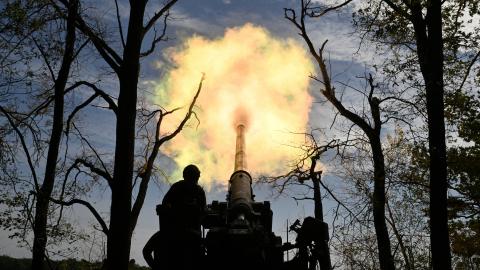Below Senior Fellow Can Kasapoğlu offers a military situation report about the war in Ukraine.
Executive Summary
• The Russian military entered the Ukrainian town of Vuhledar, increasing the likelihood that the town will fall.
• The Ukrainian military scored tactical advances in Kharkiv.
• The Kremlin prepared to draft over 100,000 conscripts and the Belarusian Armed Forces held large-scale inspections.
• Russia launched a record number of Shahed drones at Ukraine in September, a result of continued collaboration with Iran.
• Russia may be considering joint drone production efforts with China, a dangerous possibility for Ukraine and the West as a whole.
1. Battlefield Assessment
As previous editions of this report projected, the Ukrainian town of Vuhledar is on the brink of falling to Russian forces. The Russian military has secured a foothold in the city’s east, and the Kremlin continues to send reinforcements to the area. With the town almost fully encircled, Moscow’s 430th Motor Rifle Regiment and 5th Tank Brigade have also entered the western outskirts of Vuhledar.
Notably, Ukrainian military leaders have relieved the commander of Kyiv’s 72nd Mechanized Brigade, the main formation conducting defensive combat operations to hold Vuhledar, and appointed him to another post. Open-source intelligence suggests that the Ukrainian military is gradually withdrawing from the embattled city, though the Ukrainian high command denies this.
In Ukraine’s east, Pokrovsk and Toretsk remain flashpoints. Toretsk witnessed intense urban warfare this past week, while detachments from Russia’s 90th Tank Division pushed deeper into Pokrovsk. The Russian offensive has now made it as far as Zavitne. Ukraine’s Office of the Prosecutor General stated that the Russian military executed 16 prisoners of war (POWs) in Donetsk Oblast, continuing Russia’s practice of extrajudicial killings.
Ukraine has recently achieved tactical successes in Kharkiv. Ukrainian combat formations’ smooth capture of the Volchansky chemical plant in Vovchansk, an important tactical hub for the Kremlin’s troops, dealt a considerable blow to the Russian military. Still the situation in Kharkiv remains in the balance, with no large-scale territorial changes seemingly imminent.
Moscow continued to deploy troops in the Russian region of Kursk, reflecting a greater awareness of the gravity of the situation there. Elite combat formations, likely from alpha teams of Russia’s Federal Security Service (FSB), operated first-person-view (FPV) drones, while the Ukrainian military also conducted tactical drone warfare in the area. Russian airborne troops continued to operate in the region, as they have in previous weeks.
To protect against a potentially decisive Ukrainian long-range salvo, the Kremlin worked to cement the defenses around the Kerch Bridge, which connects occupied Crimea to Russia. The Russian Aerospace Forces (VKS) also intensified air attacks around Zaporizhzhia, killing Ukrainian civilians.
2. Russia Conscripts New Fighters as Belarus Conducts Military Exercises
Under a decree issued by Russian President Vladimir Putin, Moscow’s Defense Ministry is set to conscript 133,000 young men for military service from October to December of this year.
Russia drafts military-age men twice per year. Last spring, the Kremlin conscripted 150,000 soldiers; with this fall’s additions, Moscow will have enlisted over 280,000 fighters in 2024. This outnumbers the standing armed forces of most North Atlantic Treaty Organization (NATO) member states. Russia reportedly aims to constitute a fighting force of 1.5 million active servicemen by the end of this year—unsurprising given that it may weather over 1,000 casualties on any given day in Ukraine.
Russian law stipulates that conscripted personnel can be fielded in combat operations after they complete basic training, and further mandates that their deployment should be limited to four months. While the Kremlin has promised that the Russian military would not send draftees to Ukraine, conscripts have already fought in Kursk, evoking negative reactions from many military families.
Meanwhile, the Defense Ministry of Belarus announced a large-scale military readiness inspection. The exercise will focus on air force and air defense troops, and the ministry has called up reservists to man these units’ ranks. The drills will involve two air defense brigades, two electronic warfare brigades, and five air defense regiments across three air bases. In late August Kyiv claimed that Belarusian strongman Aleksandr Lukashenko had amassed troops and paramilitaries from the Wagner private military company along the border with Ukraine. In an interview, Lukashenko acknowledged these troop deployments.
3. September Witnesses Record-High Shahed Drone Attacks
The Russian military’s use of Shahed drone warfare systems has reached an alarming level. In September 2024, the Kremlin’s missile forces fired 1,300 Shahed drones at Ukraine, a record for any single month since the start of the war. September did not see one day without a Russian Shahed salvo. This relentless operational tempo underscores why Ukraine and its partners urgently need both military and political responses to Russia’s drone warfare efforts.
Previous editions of this report drew attention to the growing threat that Russia and Iran’s drone warfare collaboration poses. In August 2024 Russia hit Ukraine with 800 Shahed munitions. The significant increase in the munitions’ use from August to September indicates that the joint Russia-Iran drone plant in Tatarstan is producing a large number of drones.
Press sources have reported the potential of joint drone production efforts between Russia and China. This is a worrisome possibility. If Moscow works with Beijing to replicate Russia’s drone warfare partnership with Iran, the results could be catastrophic. This looming threat should be a cause for concern and a call to action for defense strategists in Kyiv and across NATO.


















